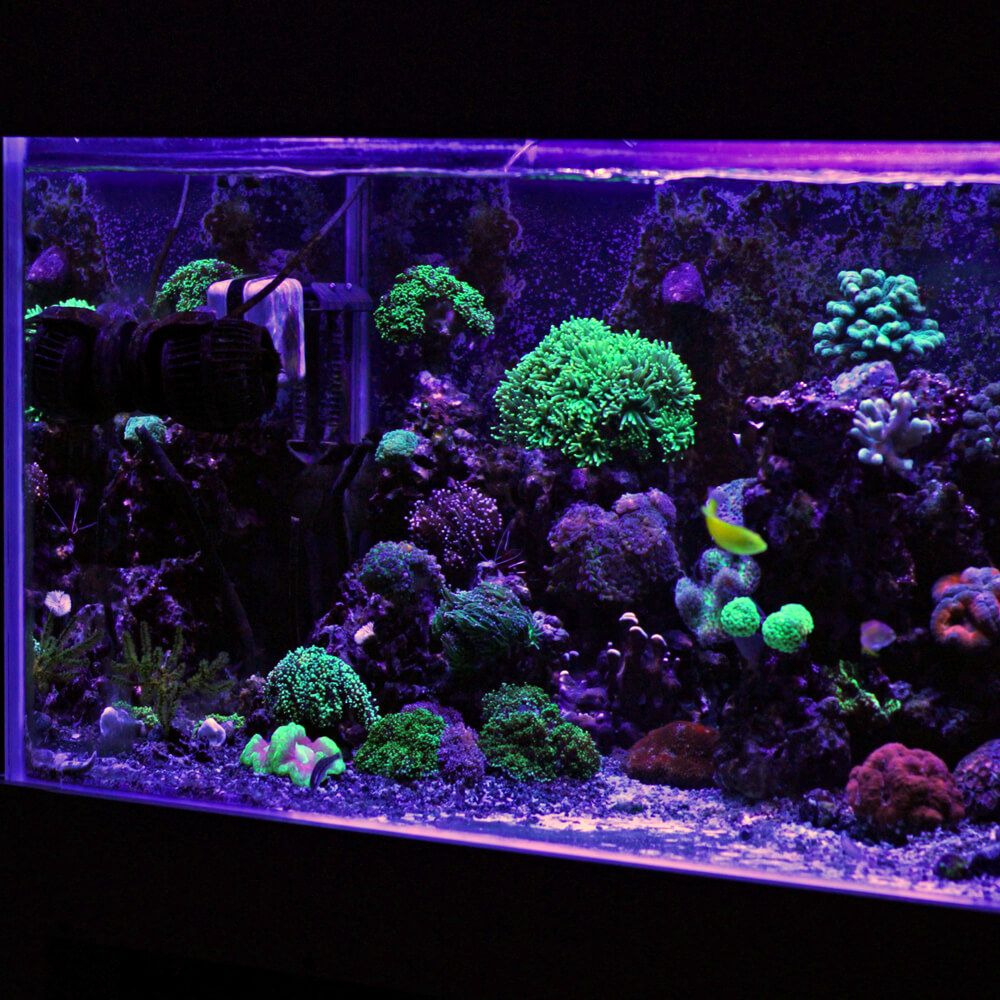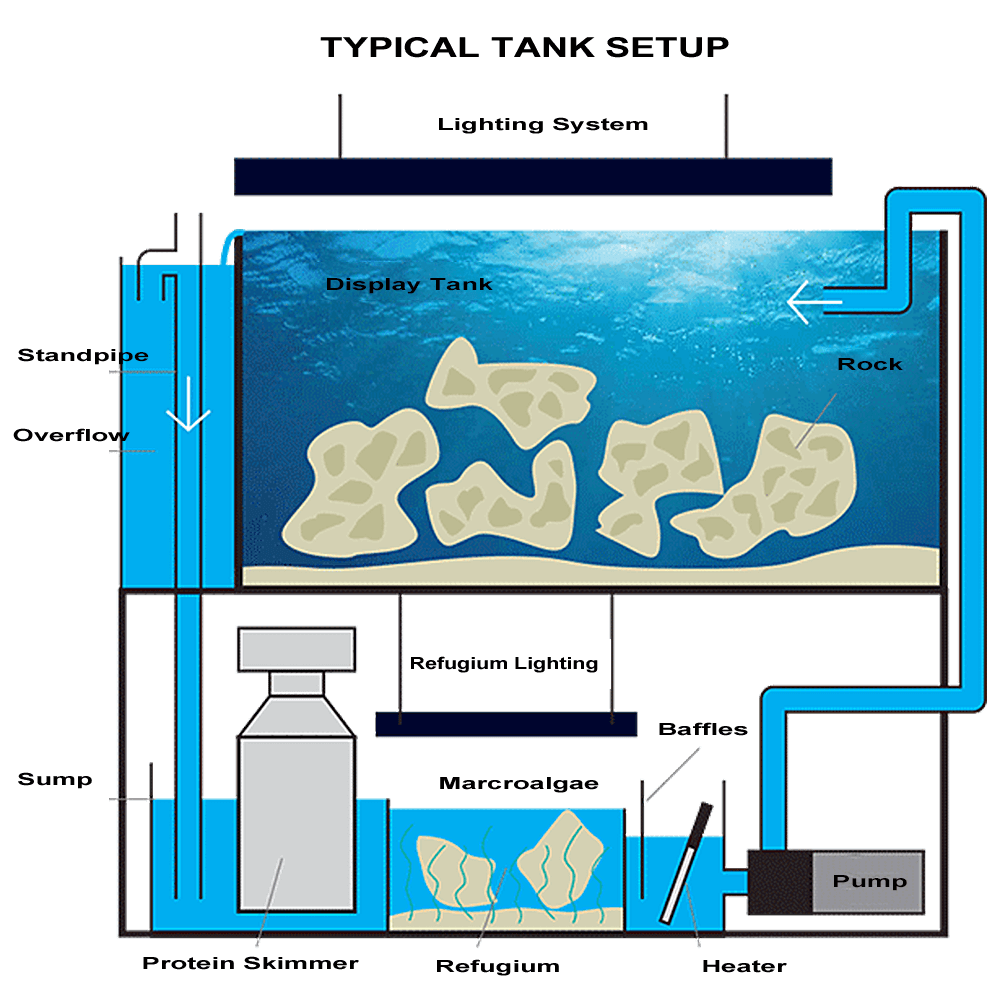WANT TO MAKE A SPLASH? WE CAN TEACH YOU A THING OR TWO.
SALTWATER TANKS 101
An aquarium can be the most beautiful accent in your home or office if done correctly. If you’re ready to make the commitment, you’ll need more than just purchasing a tank, sand, filter and lighting. You don’t need a marine biology degree to be a successful marine hobbyist, but you do have to put in the time to learn and understand your aquarium’s water chemistry. Without that, it will be very difficult to create an optimum reef environment.
If choosing the right aquarium and filters while maintaining water and lighting conditions seems daunting, we’re here to help!
Just give us a call at 204-963-8663, or come visit us at 156 St Anne’s Rd. We’ll help you make educated decisions so you can create and sustain a well-balanced saltwater ecosystem for many years to come.
Success is not a destination, it’s a journey.
~ Zig Ziglar

THINGS TO CONSIDER
If you can’t come see us right away, please enjoy the free educational tips below. This will get you started on the basics you need to know before starting your own saltwater aquarium.
-
Water
The key to maintaining a healthy saltwater aquarium is Reverse Osmosis water. Unlike tap water, it contains little to no dissolved solids. Using tap water will result in excess nutrients (phosphate, for example) and eventually increase algae growth. If tap water is your only current option, it must be used with a chlorine conditioner.
-
Heaters
Heaters The heather choice should be based on your aquarium’s water volume. Heaters play a very important role in maintaining the right temperature in your aquarium. You should aim to maintain water temperature of 78-82 degrees Fahrenheit (26 – 28 degrees Celcius).
-
Filtration
In smaller or nano tanks (0 – 20 gallons), hang on the back filters are a great way to increase water flow and to clear up the water with the use of a carbon source such as charcoal. Smaller tanks hold a smaller bioload than larger aquariums and therefore can get away with simpler filters. They can also be modified to hold macroalgae (chaetomorpha, caleurpa) or plants (mangroves) to increase biological filtration. Canister filters are used to filter medium to larger aquariums (20 – 80 gallons). They are quiet and can hold a lot of bacteria. Sumps make your aquarium esthetically more appealing by holing all the equipment together and out of sight. Sumps increase the water level in your aquarium, leading to parameters remaining in rage longer and therefore creating a more forgiving system.
-
Protein Skimmers
Protein skimmer remove excess nutrients such as proteins, amino acids, as well as fat and carbohydrates molecules form the water column, by forming bubbles that attract or repel those proteins and amino acids. Choose a skimmer that creates smaller bubbles over one that creates larger ones. The skimmer should be chosen based on the water volume of your aquarium and how many fish and inverts you are planning to keep.
-
Substrate
When it come to sand, you must only use aragonite sand rather than play sand or lake beach sand. Aragonite sand helps with coral and coralline algae growth by leaching beneficial minerals such as calcium and magnesium. To increase the biological filtration, and have a great denitrifying bed, create a 4-5 inches deep sand bed. The deep sand bed is a great place for biological filtration because basoycteria will house this porous space.
PROPER ACCLIMATION
The way you introduce these beautiful species into your aquarium will dramatically increase or decrease your success as a hobbyist. Shipping can be a stressful process for them and careful acclimation with a little love, patience and care for the first few days will insure long-term success. Fish, invertebrates, and corals need to be slowly acclimated to their new environment to lessen the stresses of shipping, changes in water quality, temperature, and lighting. Invertebrates are especially sensitive to change and need an even slower acclimation and require full strength saltwater levels that include:
-
SPECIFIC GRAVITY
1.025-1.027
-
ALKALINITY
8 DKH
-
CALCIUM
450
-
MAGNESIUM
1300+
-
PHOSPHATE
0
-
NITRATE
0
You can use either the floating bag method or the drip method to acclimate your livestock. For precautionary biosecurity reasons, be careful not to let any of the bag water get into your sump/tank.
THINGS TO REMEMBER
-
Keep lights dim when removing fish from the box to avoid blinding fish
-
Clams need to be kept underwater at all times. If exposed to air, turn the clam sideways until air bubbles escape.
-
Snails, starfish and other invertebrates are very sensitive to changes in salinity and water chemistry and need slower drip acclimation.
-
Over-acclimation causes oxygen depletion and harms your aquarium. Avoid this by taking the time to learn what is appropriate for the specific species you’re about to purchase. You can give us a call at 204-963-8663 or visit us at the store if you’re unsure about what is appropriate for your aquarium.
FLOAT METHOD
The first step is to inspect the box for any rough handling during the shipment. If you find damage, snap a picture of it for documentation purpose. Second important step is to make sure you have some pre-mixed saltwater on hand to refill your tank at the end of this process. Take the livestock out one bag at a time. Make sure to acclimate any fish in a dim lit area. Bright lights can blind fish. Float the unopened bag in your tank or sump for 15-20 minutes to adjust water temperature. Carefully cut the top and remove outer bags, undo the rubber band and roll down the sides of the innermost bag to create a float. Inspect the livestock for any indication of severe stress. If bag water smells extremely foul, or discoloured a dip is recommended after acclimation. Gently float the bag in your tank or sump. Add small amounts of tank water every few minutes to the bag until about 75% of the bag is tank water. When you remove your coral from the bag, place it at mid-tank or lower. Remove the float bag and dispose of the water. Do not let bag water into tank or sump. For the first couple of days, with mild alternating current, slowly bring the corals higher in the tank to acclimate them to more intense lighting over a period of about 2 weeks. After a few days in your tank you can move the corals to their final location. With your corals you can also try a Coral Dip Method. Dipping SPS corals in iodine as a biosecurity measure can help reduce pathogen introduction into your system. If you chose to coral dip, use a commercial product intended for this process. Allow the already acclimated corals to stay in dip water in a separate container and only use this method as directed by the manufacturer. Rinse the corals with tank water prior to placing them in your tank. DO NOT dip soft, LPS, anemones or fish! DO NOT allow dip water into your tank!
DRIP METHOD
Place a container next to your tank or sump to acclimating your inverts. Carefully open the bag and pour the water in the bag into the container, remove the invert and place it in the container. Take a piece of small diameter hose like RO line and tie a couple of knots in the line. Place one end in the tank or sump and with the other end begin a tap with the hose and allow the drips of tank water to fall into the container with the acclimating inverts. Slowly drip acclimate at a rate of 2-3 drops tank water/second for about an hour. Snails, starfish and some other inverts are even more sensitive and must be slowly drip acclimated for 6-8 hours minimum to insure long term survival, but for most other invertebrates a shorter acclimation is sufficient. The flow rate can be crudely adjusted to a few drops a second by loosening or tightening the knots in the hose. Caution: Insure that the line remains in the tank and drips into the container and only use this method if you will be present throughout the acclimation process to prevent floods. A small low volume powerhead may be added to the acclimation container to provide circulation and help assure the container water is well oxygenated.
LIVE SAND AND ROCK RUBBLE
Add live sand and rock rubble directly into your tank, along with macro algae.
LIVE ROCK
When unpacking your live rock inspect each piece for any sponges, or dead plant life. With a small brush gently scrub dead plant life and sponge off of rock. Rinse live rock in a bucket of saltwater before placing in tank for curing.
LIVE SAND AND ROCK RUBBLE
To prevent unwanted pests from being introduced into your tank, it is highly recommended that all livestock be quarantined in a separate tank for 2-4 weeks before adding to your main display tank. This will also help newly acquired livestock to adjust to your feeding regime and maintenance schedules before being added to a tank with other animals.
